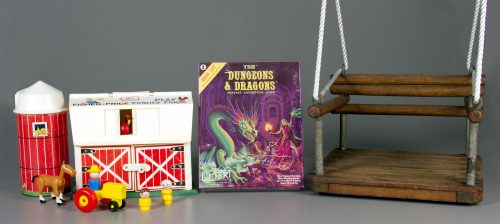Uno, Pinball, and Magic 8 Ball Inducted in to National Toy Hall of Fame
09 Nov
Posted by David Miller as Card Games, Other
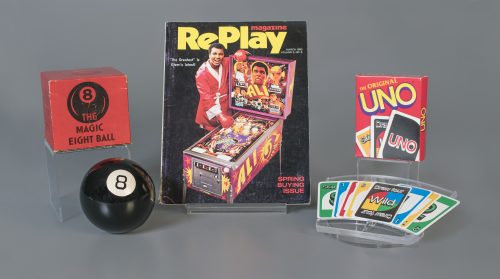
The card game Uno, along with pinball and the Magic 8 Ball, were Thursday inducted in to the National Toy Hall of Fame at the National Museum of Play in Rochester, New York. Selection for the Hall of Fame recognizes toys that have “inspired creative play and enjoyed popularity over a sustained period.”
Uno was invented in 1971 by an Ohio father as a variation on Crazy Eights to play with his family. He financed the initial print run of 5,000 games himself but later sold the rights to International Games, which itself was acquired by Mattel in 1992. Gameplay involves getting rid of one’s cards by matching color, number, or symbol, as well as playing wild cards or cards that affect turn order.
Other toys in the Hall of Fame include Etch A Sketch, jigsaw puzzles, marbles, and last year’s inductees, Clue, the Wiffle Balle, and paper airplanes.
- Comments Off on Uno, Pinball, and Magic 8 Ball Inducted in to National Toy Hall of Fame
2018 National Toy Hall of Fame Finalists
13 Sep
Posted by David Miller as Card Games, Classic Board Games, Modern Board Games
On Wednesday, The Strong in Rochester, New York announced its list of finalists for this year’s induction in to the National Toy Hall of Fame. The group includes four games, as well as a variety of toys, branded and generic:
- American Girl dolls
- chalk
- Chutes & Ladders
- Magic 8 Ball
- Fisher-Price Corn Popper
- Masters of the Universe
- pinball
- sled
- Tic-Tac-Toe
- Tickle Me Elmo
- Tudor Electric Football
- Uno
Final inductees will be announced November 8th but through the 19th of this month, the public can contribute to the selection by voting online collectively one of the 23 member committee.
Among the previous 65 inductees are playing cards, jump rope, Dungeons & Dragons, Monopoly, Mr. Potato Head, roller skates, Barbie, and Scrabble.
- Comments Off on 2018 National Toy Hall of Fame Finalists
Clue, Wiffle Ball, and Paper Airplane Inducted in to the National Toy Hall of Fame
09 Nov
Posted by David Miller as Modern Board Games, Other
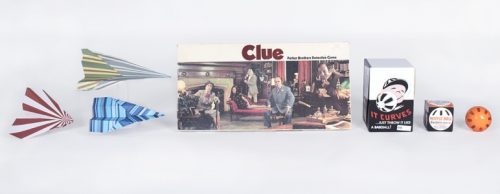
Earlier today, in a ceremony held at The Strong’s National Museum of Play, Clue, the Wiffle Ball, and paper airplanes were inducted in to the National Toy Hall of Fame. Selection for the Hall of Fame recognizes toys that have “inspired creative play and enjoyed popularity over a sustained period.”
Clue, modeled after murder-mystery dinner parties, was invented by a British couple during the war years but did not see publication by Waddingtons, under the name “Cluedo”, until 1949. The game was soon thereafter purchased by Parker Brothers and released in the United States as “Clue”.
The Wiffle Ball, a hollow, plastic baseball replacement, was invented in the 1950s. Holes cut in the plastic ball slow its movement, allowing play in more cramped spaces and with fewer broken windows, as well as some mean curves even by amateur pitchers [all still important features when we played on 180th Terrace back in the late 70s and early 80s].
The origin of paper airplanes is said to date back to 1909, just a few years after the Wright brothers’ first flight.
These three toys were chosen by a panel of industry judges from a field of 12 finalists. Among the 62 previous inductees are marbles, Dungeons & Dragons, the Slinky, Barbie, puppets, and alphabet blocks.
- Comments Off on Clue, Wiffle Ball, and Paper Airplane Inducted in to the National Toy Hall of Fame
Dungeons & Dragons Inducted in to National Toy Hall of Fame Along With Swing and Little People
10 Nov
Today, Dungeons & Dragons, the swing, and Fisher-Price Little People were inducted in to the National Toy Hall of Fame in Rochester, New York. Each year, the Hall of Fame at The Strong’s National Museum of Play recognizes two or three toys for longevity, innovation, achieving icon status, and fostering discovery.
Regarding D&D, Curator Nic Ricketts was quoted:
More than any other game, Dungeons & Dragons paved the way for older children and adults to experience imaginative play. It was groundbreaking. And it opened the door for other kinds of table games that borrow many of its unique mechanics. But most importantly, Dungeons & Dragons’ mechanics lent themselves to computer applications, and it had a direct impact on hugely successful electronic games like World of Warcraft.
Past inductees include the Barbie dolls, Chess, the Atari 2600 Game System, Lincoln Logs, the rubber duck, Slinky, Twister, and other toys and games.
- Comments Off on Dungeons & Dragons Inducted in to National Toy Hall of Fame Along With Swing and Little People
2016 National Toy Hall of Fame Finalists
15 Sep
Posted by David Miller as Card Games, Modern Board Games, Other, RPGs
The National Toy Hall of Fame at The Strong National Museum of Play has announced 12 finalists for potential induction in the class of 2016. The finalists are:
- Bubble Wrap
- Care Bears
- Coloring Book
- Clue
- Dungeons & Dragons
- Fisher Price Little-People
- Nerf
- Pinball
- Rock ‘Em Sock ‘Em Robots
- Swing
- Transformers
- Uno
Final selection of inductees will be made by a national advisory committee and the results announced November 10th. Usually 2-3 are chosen. Criteria include:
- Icon-status—the toy is widely recognized, respected, and remembered.
- Longevity—the toy is more than a passing fad and has enjoyed popularity over multiple generations.
- Discovery—the toy fosters learning, creativity, or discovery through play.
- Innovation—the toy profoundly changed play or toy design.
- Comments Off on 2016 National Toy Hall of Fame Finalists
Twister Inducted in to the National Toy Hall of Fame
07 Nov
Posted by David Miller as Modern Board Games
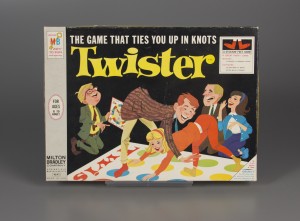 The Strong and National Museum of Play have announced the 2015 class of inductees to the National Toy Hall of Fame. Sharing the honor with puppets and the Super Soaker is the game, Twister.
The Strong and National Museum of Play have announced the 2015 class of inductees to the National Toy Hall of Fame. Sharing the honor with puppets and the Super Soaker is the game, Twister.
The invention of Twister dates back to 1964 but by 1966 Milton Bradley had already given up and called off further production of the game, which some considered too racy. Then in an appearance on the Tonight Show, Twister was played by Johnny Carson and Eva Gabor. In 1967, it sold more than 3 million copies.
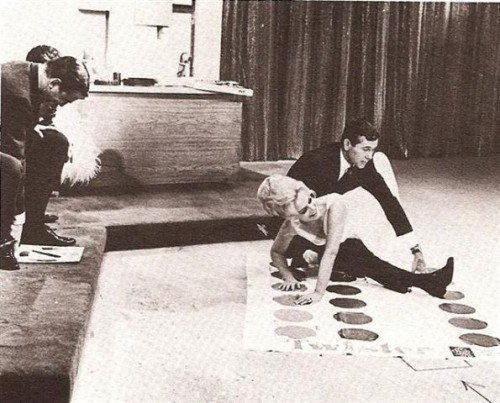
- Comments Off on Twister Inducted in to the National Toy Hall of Fame
2013 National Toy Hall of Fame Inductees
08 Nov
Posted by David Miller as Classic Board Games, Other
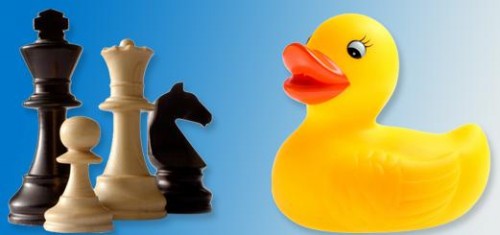 Thursday was a good day for the game of Chess. As if international excitement over a world championship match wasn’t enough, Chess was inducted in to the National Toy Hall of Fame in the National Museum of Play.
Thursday was a good day for the game of Chess. As if international excitement over a world championship match wasn’t enough, Chess was inducted in to the National Toy Hall of Fame in the National Museum of Play.
So was the rubber duck.
- Comments Off on 2013 National Toy Hall of Fame Inductees
Pawn About Town—National Museum of Play in Rochester, New York
13 Aug
Posted by David Miller as Card Games, CCGs, Classic Board Games, Electronic Games, Miniatures, Modern Board Games, RPGs, War Games
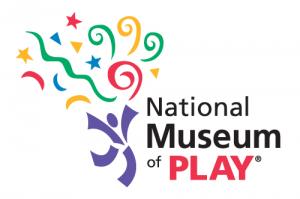 What a thrill! Recently, I had the privilege of visiting the National Museum of Play in Rochester, New York. The Museum, an arm of The Strong institute, is dedicated to everything play—toys, games, puzzles, sport, role-play, etc. Among it’s current exhibits are one celebrating comic book heroes, one providing kids a fully-stocked scale grocery store to play shopping, and one that brings to life children’s literature with a kid-sized fairy tale forest.
What a thrill! Recently, I had the privilege of visiting the National Museum of Play in Rochester, New York. The Museum, an arm of The Strong institute, is dedicated to everything play—toys, games, puzzles, sport, role-play, etc. Among it’s current exhibits are one celebrating comic book heroes, one providing kids a fully-stocked scale grocery store to play shopping, and one that brings to life children’s literature with a kid-sized fairy tale forest.
The real strength of the Museum, though, is how it integrates play, preservation, and education. Within each of the exhibits, displays of artifacts are side-by-side with related fun activities. This really gives the visitor a good sense of historical trends in play. It also helps make the museum as interesting to adults as it is to children.
In fact, despite all the interactive exhibits and fun activities, one shouldn’t be misled into thinking that the National Museum of Play is just a children’s museum or playhouse. The Strong and Museum are also dedicated to the serious study of play. The Museum houses one of the largest collections of play objects (toys, games, and other stuff) anywhere (much of which is available for perusal online), maintains a large library of professional publications, manages several unique archives, and offers fellowships for researchers.
My visit to this fantastic institution was facilitated by Nicolas Ricketts, Curator; Susan Trien, Senior Director of Public Relations; and Julia Rossi, Archivist. The three gave me a guided tour of the game-related exhibits, as well as the opportunity to examine the Sid Sackson and Philip Orbanes archives.
Boardwalk Arcade
Boardwalk Arcade is a celebration of summer, carnivals, and beach-side resorts. Artifacts on display include vintage advertising posters and models of amusement park rides. For activities there is Skee Ball, Whack-a-Mole, and a variety of pinball machines. Open now through September 8th, Boardwalk Arcade would be a particularly great activity for a rainy summer day.
National Toy Hall of Fame
Inductees to the National Toy Hall of Fame include such classic playthings as marbles, Barbie dolls, Mr. Potato Head, Scrabble, Dominoes, and Star Wars action figures. All are on display in a special section of the museum upstairs. The 2013 inductees will be announced on November 7th.
Starting in 2015, the National Toy Hall of Fame will be combined with the Toy Industry Association’s Hall of Fame, which focuses on people in the toy industry. Past inductees to the latter include Walt Disney, George Lucas, F.A.O. Schwarz, and the Hassenfeld brothers (founders of Hasbro). A $4 million project will transform the museum’s existing Hall of Fame space with a 100 foot long, 20 foot high LED theatrical screen and interactive play environments.
Monopoly: An American Icon
Monopoly gets its own exhibit at the Museum of Play. Highlighted at the center of Monopoly: An American Icon is Charles Darrow’s original handmade board—round, according to legend, to fit his dining room table. Surrounding that board are displays showing the historical evolution of Monopoly from the 1906 Landlord’s Game. There are early folk-art versions of Monopoly, Charles Darrow’s tie-box Monopoly (his first commercial product, sold in Philadelphia department stores), modern branded games, and Hasbro’s recent releases.
Game Time
Game Time is an exhibit all about our favorite subject: GAMES! Between the giant-sized, free-to-play-with versions of Perplexus, Battleship, Connect Four, and Rush Hour are two main display sections—one exploring games by genre and one showing the history of games in a timeline. The genre displays cover logic puzzles, jigsaw puzzles, word games, matching games, strategy games, roleplaying games, race games, party games, card games, dexterity games, and wealth games—each with both modern and antique examples, as well as information on their historical context. There’s so much to learn here about what makes a game, what value games add to play, and how different games tie in to different human needs and social relationships.
But if that’s sounds too serious for you, it’s also a lot of fun just to see older games compared side-by-side to modern ones of similar type.
The timeline section starts in the 1800s and ends at the present—so it’s more of a look at the development of modern games than a study of their ancient origins. Still, there’s a lot to learn about trends in game design and how games have been viewed in modern culture. One of the things that’s apparent, for example, is that the tension between games being seen as primarily educational tools or entertainment is cyclical.
Archives
Not everything at the Museum is on display. Among the archives and collections of the Museum are personal papers and prototypes of game designer, Sid Sackson, and Monopoly expert and former Parker Brothers executive, Philip Orbanes. Getting to examine them in person was the highlight of my visit. Imagine holding in your hands the manuscript to the rules for Acquire!
Did you know that when Sid Sackson received a new game, he’d throw away the box to save on storage space?
Like many game designers I know, Sackson kept a detailed notebook of all his game ideas. But he also used the same diaries to take notes for meetings and record business details. At the end of the year, he’d index them by game and person.
One item in the Philip Orbanes collection was a personal scrapbook of George S. Parker, a founder of Parker Brothers. In it was correspondence of Parker with his company’s British representatives following a trip he’d made to assess the market there just after World War I.
- Comments Off on Pawn About Town—National Museum of Play in Rochester, New York
Trending
- Massdrop.com
- Oh the Irony—Illuminati Card Game Continues to Inspire Conspiracy Theorists
- Home
- Footprints, an Educational Ecology Game
- USPS Adds Board Game Flat Rate Box
- Baila, the Estonian Drinking Card Game
- Crystal Caste Wins Dice Patent Suit Against Hasbro
- Mirror Game, Red and Blue
- Are Board Games Dangerous?
- The Truth About Dominoes On Sunday in Alabama
Archives
Most Popular Articles
- Oh the Irony—Illuminati Card Game Continues to Inspire Conspiracy Theorists
- The 20 Most Valuable Vintage Board Games
- The Truth About Dominoes On Sunday in Alabama
- Sequence Game, and Variants
- USPS Adds Board Game Flat Rate Box
- Baila, the Estonian Drinking Card Game
- The 13 Most Popular Dice Games
- Are Board Games Dangerous?
- Guess Who? The Naked Version
- What Happened to the Jewel Royale Chess Set?
Recent Posts
- Toy Fair 2019—Breaking Games
- Talisman Kingdom Hearts Edition
- Toy Fair 2019—Winning Moves
- Toy Fair 2019—Games Workshop
- Toy Fair 2019—Star Wars Lightsaber Academy
- Toy Fair 2019—Stranger Things Games
- Toy Fair 2019—HABA
- Licensing Roundup
- Game Bandit
- 2018 A Difficult Year For Hasbro But Not For D&D Or MtG
Recent Comments
- on Toy Fair 2019—Winning Moves
- on Game Bandit
- on Second Look—Dungeons & Dragons Waterdeep Dragon Heist
- on Crowdfunding Highlights
- on Beyblade SlingShock
- on Game Bandit
- on Game Bandit
- on Watch This Game!, the Board Game Review Board Game
- on Second Look—Vampire: The Masquerade 5th Edition
- on Palladium Books Loses Robotech IP License, Cancels Five-Year-Overdue Robotech RPG Tactics Kickstarter


